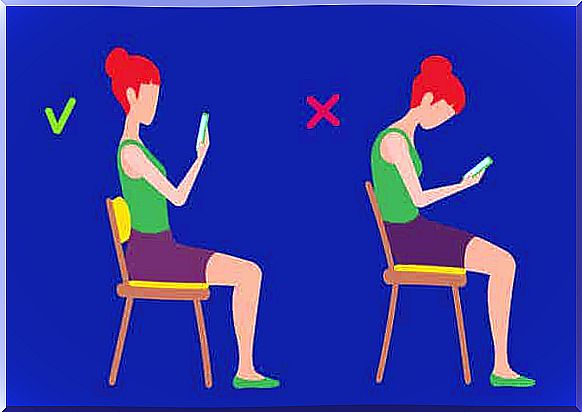The Causes Of Mobile Neck And How To Avoid It

So-called “technological diseases” are increasing. Mobile neck is one of them. This is because the use of new technology is becoming increasingly common in people’s daily routine. Almost everyone uses mobile phones, laptops and tablets every day, be it at work or leisure and fun. The thing is, few people use them properly.
According to a study published by CBS News, people spend an average of two to four hours with their necks bent due to the use of this type of electronic device. This corresponds to 700-1400 hours a year and leads to syndromes such as mobile neck. What is it really? What are the symptoms? What causes it? Keep reading to find out.

What is mobile neck? What causes it?
Mobile neck is also known as also called computer neck and office shoulders. It is considered a technological disease caused by bending the neck repeatedly when using the mobile phone. Repeating this bad posture can cause great physical discomfort.
This syndrome also appears when you spend many hours looking at your mobile phone when, for example, checking news or social media (you do not need to send text messages). As you can see, it is a result of bad attitude and bad habits.
The symptoms of mobile neck
Mobile neck comes from the recurring habit of bending the neck when looking at mobile phones (or other similar devices). It is a practice that can cause real physical discomfort. Thus, the most characteristic symptoms of mobile neck are pain and stiffness in the neck, poor posture, headaches and back pain.
It can also cause other conditions, such as tendinopathy or tendonitis (a tendon disorder that causes the type of pain that worsens with movement, as well as inflammation and worsening of tendon function). Thus, this disorder can cause dysfunctions of the neuromusculoskeletal system.
Joint alignment may change if the spine does not function properly, causing disorders such as disc herniation, cervical spondylosis and contractures, among other symptoms.
Related ailments
In addition to mobile neck, overuse of the thumb can lead to joint tension and produce two other types of ailments:
- Quervain’s tendonitis (a type of inflammation)
- Rhizarthrosis of the thumb, which is common in those who sew
Physiotherapists’ warnings
Many of these therapists have warned against the big wave of cell neck symptoms they see in the office. Monica Rodriguez, a physiotherapist, explains, for example, that more and more people are seeking consultations because of this (and of other technological diseases that result from prolonged and incorrect use of smartphones, tablets, laptops and computers in general).
Ways to prevent teck neck
Experts recommend the following tips to prevent this and other technology-related diseases:
- Place the screen of your mobile phone, tablet or laptop just below eye level. This will keep your back straight.
- Maintain an upright position.
- Prioritize voicemails over text messages.
- Use both hands to type and place the wrist in the neutral position.
- Sit properly.
- Reduce the time you spend on this type of device.
- For computers, position the keyboard and mouse in a way that does not close the wrist. You should support your forearms and place a pillow under your wrist. According to experts, the keyboard should ideally be placed below elbow height.
- Rest every 30 minutes if you work on the computer all day.
- Do active stretching exercises for the wrists
- Do active back stretches.

Think about the little habits
Daily habits strongly affect health. As you have seen, simple things like using your cell phone can be bad for you both physiologically and psychologically. For example, one of the symptoms of mobile neck is chronic headaches.
Logically, you can prevent this and other “technological diseases” if you follow some of the tips we mentioned above. You also need to reduce the time you spend using these types of devices.
If you have already developed the syndrome, it is best to consult a physiotherapist. They can help you restore your physical and mental well-being.









